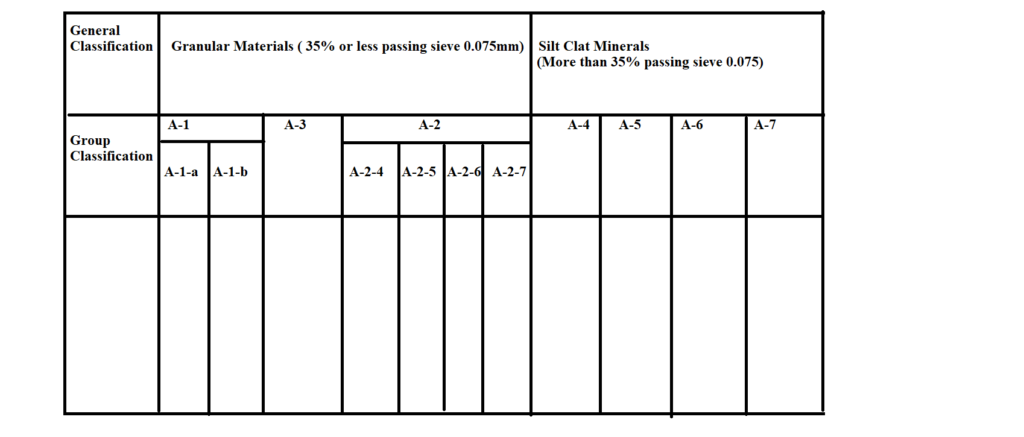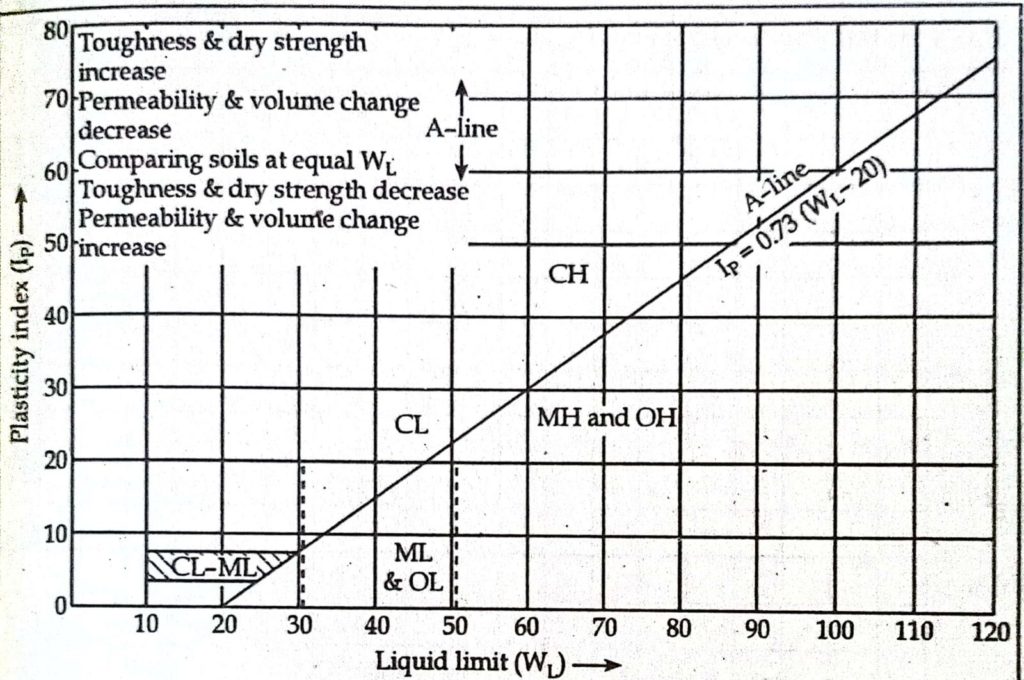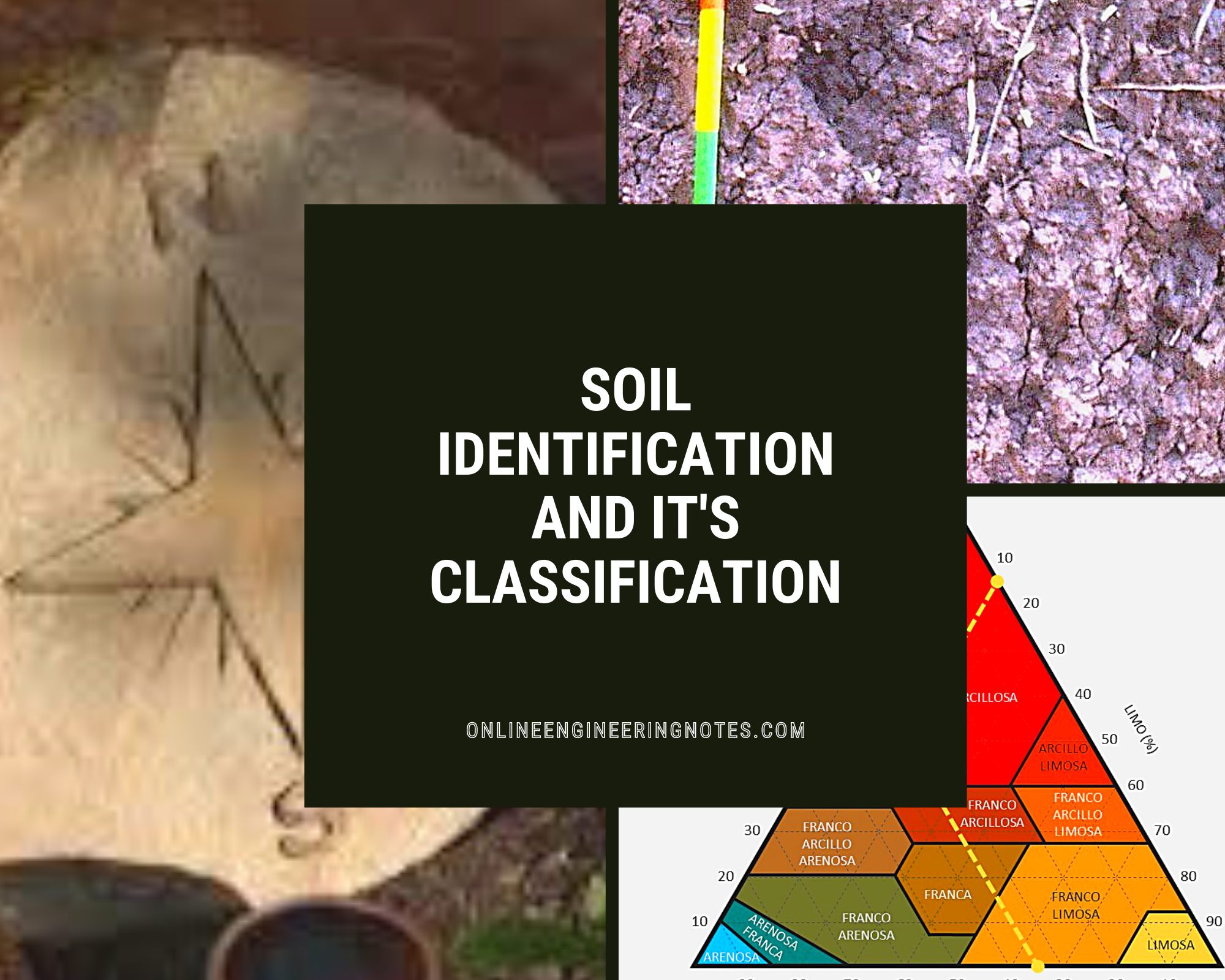1.1 Purpose of soil classification:
Soil classification is the arrangement of soils into different groups such that the soil in a particular group have similar behavior.
Requirement for soil classification
- It should have a limited number of groups.
- It should be based on engineering properties.
- It should be simple.
1.2 Field identification of soil
1. Gravel from Sand:
- Particle larger than 4.75 mm and smaller than 80 mm are gravel.
- Particle from 4.75 mm to 0.075 mm are sand.
2. Sand from Silt:
- Find sand cannot be easily distinguished from silt by simple visual examination.
- It is possible to differentiate by dispersion test.
Dispersion test:
The test consists of pouring spoonful of sample into jar of water. If the material settles down in one to two minute it is sand. If the material takes about 15 minute to 1 hour then it is silt.
3. Silt from clay:
Microscopic examination of particle are possible only in lab. In the absence few simple test are:
a. Shaking test (Dilatancy test):
In this test a part of soil mixed with water to a very soft consistency is shaken after placing in the palm of the hand. If the soil is silt water will rise quickly to the surface and give it a shiny glistening appearance. If it is clay the water cannot move easily and hence it continues to look dark. An estimate of relative proportions of silt and clay in an unknown soil mixture can be made by nothing whether the reaction is rapid, slow or nonexistent.
b. Dry strength:
The strength of a soil in a dry state is and indication of its cohesion and hence its nature. It can be estimated by crushing a 3 mm size dried fragment between thumb and forefinger. A clay fragment can be broken only with great effort where a silt fragment crushes easily.
c. Rolling test (Toughness test):
A thread is attempted to be made out of a moist soil sample with a diameter of about 3 mm. If the material is silt it is not possible to make such a thread without disintegration and crumbling. If it is clay such a thread can be made even to a length of about 30 cm and supported by its own weight when held at ends.
1.3 Soil classification system- Particle size (MIT classification), Textural, ISCS, USCS and AASHTHO soil classification system:
1. MIT System of Classification:
MIT system of classification of soil was developed by Prof. G. Gilboy at Massachusetts Institute of Technology in USA. In this system the soil is divided into four groups:

- Gravel: Particle size greater than 2 mm.
- Sand: Particle size between 0.06 mm to 2 mm.
- Silt: Particle size between 0.002 mm to 0.06 mm.
- Clay: Particle size smaller than 0.002 mm.
2. Textural Classification:

- Used to determine the percentage of sand, silt and clay size.
- This method doesn’t reveal any properties of soil.
- Suitable for soil type having particle size less than sand.
- It doesn’t provide plasticity characteristics which is essential for classification of soil.
| Soil Fraction | Diameter in mm |
| Gravel | > 2 |
| Sand | 2 – 0.05 |
| Silt | 0.05 – 0.002 |
| Clay | < 0.002 |
3. AASTHO Classification System:
(American Association of State Highway and Transportation official)
- It is particularly useful for classifying soil for highway.
- This system classifies both coarse grain and fine grained soil using particle size analysis and plasticity characteristics of soil.
- In this system soils are divided into seven types designated as A-1 to A-7 based on their relative expected quality for a road embankment.
- Some are divided into subgroups. Soils within each groups are evaluated according to the group index calculated from empirical formula.
Group Index (GI):
GI = (F – 35) [0.2 + 0.005 (LL – 40)] + 0.01 (F – 15) (PI – 10)

- Greater the GI value lesser desirable a soil for highway construction.
- A soil with lower number A-1 is more suitable for highway material than A-4.
- In AASTHO system initially there was now place for organic soil. So additional group A-8 was introduced for peat.
4. Unified Soil Classification System:
(USCS)
It is the most popular system for use in all types of engineering problems involving soil.
The various symbol used are:
| Symbols | Description | |
| G | Gravel | |
| Primary | S | Sand |
| M | Silt | |
| C | Clay | |
| O | Organic | |
| pt | Peat |
| Symbols | Description | |
| W | Well Graded | |
| Secondary | P | Poorly Graded |
| L | Low Plasticity | |
| H | High Plasticity |
a. Coarse grained soil:
If more than 50% of soil mass contains particles which are larger than 0.075 mm which could not pass 0.075 mm sieve.
If fines ≤ 5%
- Soil is well graded and gravel. Then it is represented by GW.
- Soil is poorly graded and gravel. Then it is represented by GP.
- If soil is sand.
SW: Well Grained Sand
SP: Poorly Grained Sand
If fines ≥ 12%
- Soil is gravel and contains silt as its fines represented as GM.Similarly for sand.
SM: Silty Sand
- Soil is gravel contails clay as its fines as GC.Similarly for sand.
SC: Clayey Sand
If fines 5 – 12%
- Soil is well graded gravel with 8% of -silt.
GW – GM
- Soil is poorly graded gravel with 8% of silt.
GP – GM
- Soil is well graded gravel with 9% of clay.
GW – GC
- Soil is poorly graded gravel with 9% of clay.
GP – GC

b. Fine – grained soil:
If more than 50% of soil passes from 0.075 mm sieve.
- LL after oven dried – LL before oven dried = ≥ 30% it is organic soil ( OH & OL).
- LL after oven dried – LL before oven dried = < 30% it is inorganic soil ( ML & MH).
| LL < 50% | LL > 50% |
| CL | CH |
| ML | MH |
| OL | OH |
c. Highly organic soil:
These soil are identified by visual inspection.
5. Indian Standard Soil Classification System:
(ISSCS)
ISSCS is similar to USCS. There is one difference in the classification of fine grained soil. The fine grained is sub- divided into three category low, medium and high.
a. Coarse-grained: Soils are same as USCS.

b. Fine grained soil:
- Low: Have less liquid limit than 35%.
- Medium: Liquid limit greater than 35% but less than 50%.
- High: Liquid limit greater than 50%.
References:
- Terzaghi, Karl, Peck, R.B & John, Wiley (1969) Soil mechanics in engineering practice, New York.
- Arora , K.R (2008), Soil mechanics and foundation engineering, Delhi: Standard Publisher Distribution.

